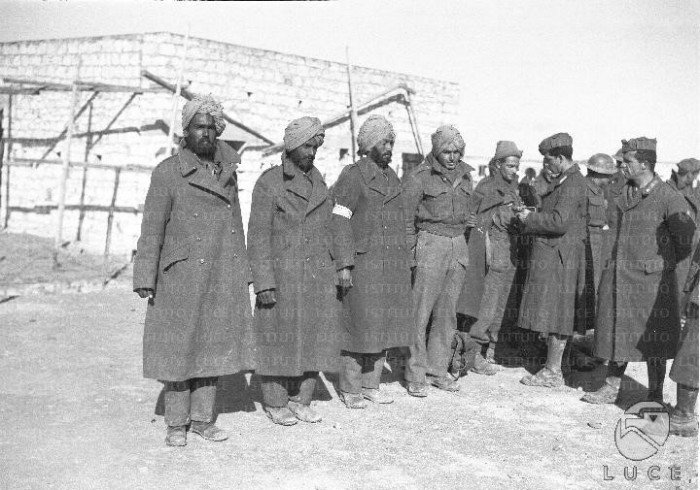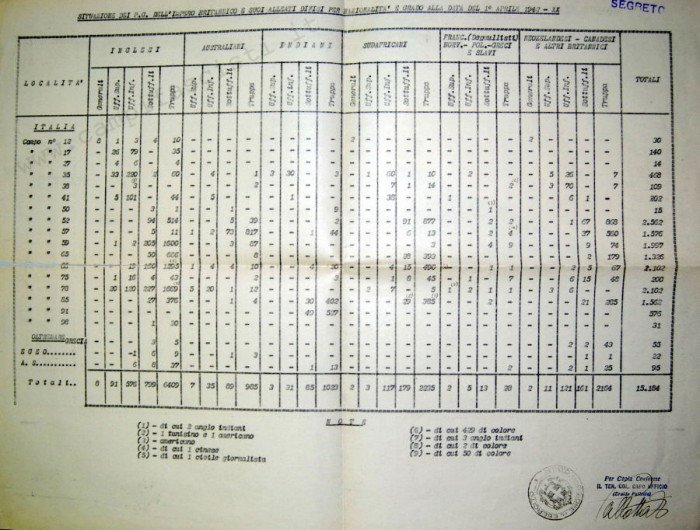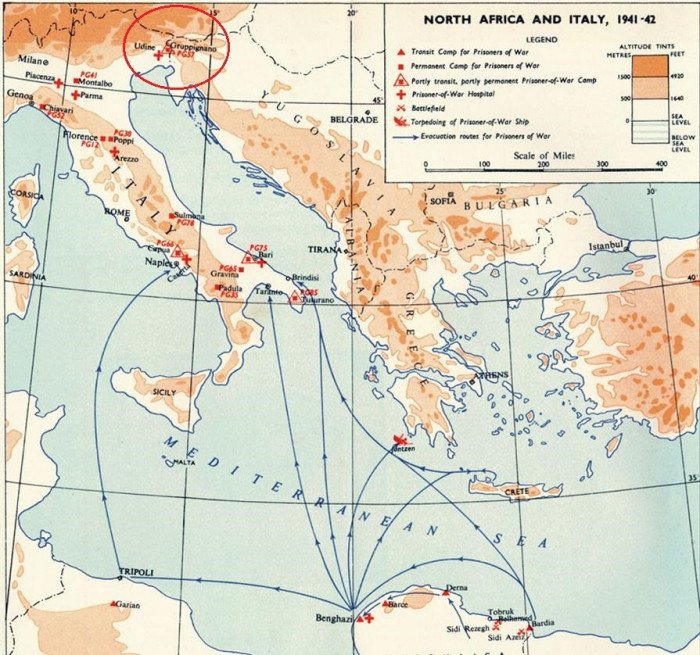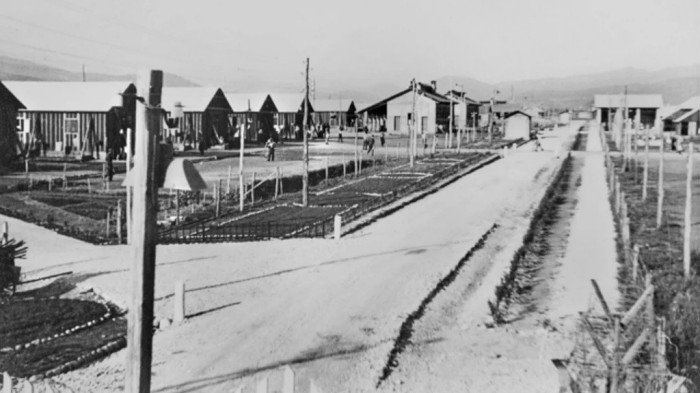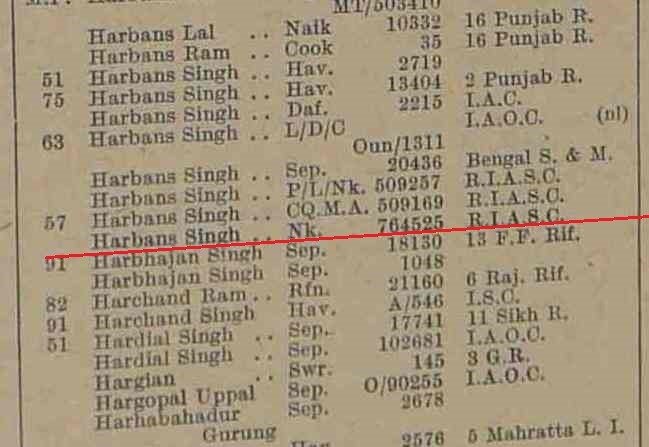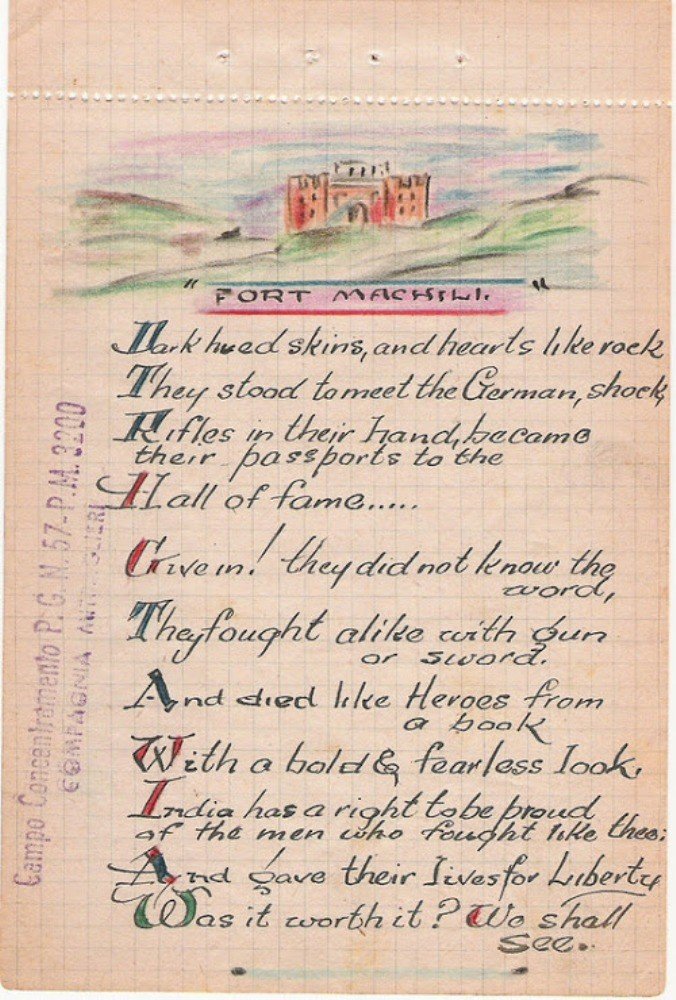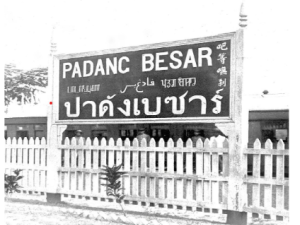This article "Get their hair cut!", written by Harprabhjeet Singh Bedi, was originally published on February 19th 2020. With historic rigor it recounts the intense life of prisoners of war, including Sikhs, during the 2nd world war. Besides the impressive past times of the Sikh prisoners the account crescendos with one Sikh who chances death by physically threatening one of his captors in order to grant an exception to all the Sikhs from having their hair hygenically cut along with all other prisoners. We are grateful to republish this article in honor of SikhNet 25th anniversary. Register to attend SikhNet's 25th Anniversary Virtual Gala.
"Get their hair cut!"
"Italian, you violate a single sacred hair of a Sikh- you die with us !!"
Just like any other faith, Sikhs have a code of conduct that directs them on different ways to live their lives. The Sikh 'Rehat Maryada' (Sikh code of conduct) directs and declares that all Sikhs have to keep their hair unshorn. The most revered Sikh symbol is hair. The Kesh (unshorn hair) is regarded with the highest importance in the Sikh faith and is one of the basic requirements for a Sikh. The Turban is required of every Sikh in order to cover his/her hair. This is a rule that he or she should observe, abide and keep.
In early December 1941, the POWs of Campo 57 Gruppignano, Italy were informed that, due to the prevalence of lice and fleas, the dictum had come from Rome that all prisoners were to have their heads shaved. Many of the POWs protested vigorously at this, but none so loudly as the few Sikhs in the camp. It is part of their belief that the hair must not be cut from birth till death, and they vowed as one that they would fight to the death before submitting to such an indignity.
This article provides some indication of how men coped with these conditions and the collective effort made to sustain morale.
Letters, diaries and recollections held in the Imperial War Museum, London & Australian War Memorial archives enable us to trace the real experiences of prisoner of wars (POWs), from initial capture through to their life in prisoner of war camps. In these accounts we are confronted with the grim realities of POW life, the boring grind of the diurnal round in the camp, and also with some evidence of deliberate maltreatment.
The quality of this treatment depended upon the morale and organisation of the enemy. POW life also varied from place to place, reflecting the influence of such factors as climate, the nationality and political doctrine of their captors or the attitudes of individual camp commandants. This variety of circumstances does much to explain the variety of POW testimony.
For the Indian prisoners conditions were still worse. They were occasionally roughed up and regularly abused. They were kept without food or water, but were tormented by the sight of both being stacked up outside their compound. An attempt was made to bribe these men; the Italians offering them water in exchange for a commitment to fight the British in Burma. The offer was contemptuously dismissed.
Harbans Singh a Sikh, held the rank of Naik or Corporal with the Indian Motorised Divisions, which in its entirety was captured at Fort Mechili south of Derna during the Western Desert Campaign. With other Indian soldiers, Harbans was taken to Rome and was subjected to intense propaganda from the Italians and Chandra Bose (an Indian Defector). It was hoped that bribes of luxuries and money would pressure them to defect, join a Free Indian Corps and broadcast anti-British propaganda to India where the messages would be beamed to their relatives.
The methods failed to break their loyalty. This was part of the plan to try and cause unrest in India and upset the British war effort. When Harbans Singh and four fellow Sikhs refused to comply with the Italian overtures they were subjected to torture and starvation which failed to break their resolve.
It was decided that the ultimate punishment for the recalcitrants would be to incarcerate them in a camp of white Colonials. They were sent to Campo 57 where the Italians expected the uncouth Australians to ostracise them and complete their punishment for non-compliance. When the Diggers learned of the Indians' brave resistance to propaganda they accepted them and willingly donated food and necessities.
British army prisoners with turbans are checked by the Italian Army. Courtesy of Archivio LUCE
Camp P.G. 57 (Campo 57) was a WWII Prisoner of War camp that interned principally Australian and New Zealand Army Corps (ANZAC) non-commissioned soldiers with smaller numbers of British, Indian and South African men with the large majority of prisoners coming from the North Africa front. The initials "P.G." denote Prigionieri di Guerra (Prison of War), often interchanged with the title Campo (field or military camp).
The camp was situated close to the city of Udine, in the Province of Friuli in Northern Italy. Friuli itself lies in the foothills of the Alps and was close to the Yugoslavian border.
Italian camps varied greatly. Some were inefficient and badly run others were easier.
Many of the prisoners eventually find themselves incarcerated in Campo 57, Gruppignano under the iron fist of the notorious Colonel Vittorio Emanuele Calcaterra of the Caribinieri (Military Police).
The reality of the situation comes through in Ron Fitzgerald's camp diary. Faithfully recorded are the deaths from dysentery, a prisoner shot for stealing wood, twenty cases of Beri Beri, another death during the first big winter freeze, prisoners going without shoes in the bitterly cold winter, hundreds of POWs coming to the camp and a Sikh prisoner committing suicide with a knife on the same day as news came through of the fall of Tripoli.
'The order was also aimed to 20 to 30 Sikhs , whose religion made it mortal sin for them to be shorn. All the rest of the prisoners eventually agreed to have their hair shaved off on condition that the Sikhs were not shorn, and the chained men were released'.
In early December 1941, the POWs of Campo 57 Gruppignano, Italy were informed that, due to the prevalence of lice and fleas, the dictum had come from Rome that all prisoners were to have their heads shaved. Many of the POWs protested vigorously at this, but none so loudly as the few Sikhs in the camp. It is part of their belief that the hair must not be cut from birth till death, and they vowed as one that they would fight to the death before submitting to such an indignity.
The Sikh 'Rehat Maryada' (Sikh code of conduct) directs and declares that all Sikhs have to keep their hair unshorn. The most revered Sikh symbol is hair. The Kesh (unshorn hair) is regarded with the highest importance in the Sikh faith and is one of the basic requirements for a Sikh. The Turban is required of every Sikh in order to cover his/her hair. This is a rule that he or she should observe, abide and keep.
Calcaterra, inspecting the morning check parade, came upon an offending beard and ordered that all beards were to be removed. The murmurs and demeanour of the rest of the men conveyed to the commandant that the order was not popular and likely to be disobeyed. Thereupon Calcaterra ordered that not only beards but also hair on the head should be removed . The order was also aimed to 20 to 30 Sikhs, whose religion made it mortal sin for them to be shorn.
A passage from Alex J.R .Barnett book is worth sharing:~
''Calcaterra, accompanied by Carabinieri, approached the prisoners, one at a time and with his drawn pistol, a biretta, pressed to the victim's head succeeded in handcuffing more men, who were promptly shorn. These victims, relieved of their handcuffs, were delivered to solitary confinement and not seen for twenty five days.
More haircuts were performed on others but these men were handcuffed and attached by irons to the buttresses, to be left suspended in the cold and snow, callously ignored until much later when a visit from the Swiss Red Cross envoys occurred and they were released.
The remaining prisoners could only stand and watch. It was at this stage, that the Colonel decided how he can improve on this former triumphs. With his entourage, he moved down the line towards the five assembled Sikhs. This procession was watched with mounting apprehension and even more deadly silence descended over the stunned Diggers. Then it all happened so quickly. Calcaterra's arrival had been anticipated by the Sikhs and before any action could be initiated, Naik (corporal) Harbans Singh broke ranks, moved swiftly to confront Colonel, grabbed him by the throat and glared at the guards. Time now froze, We watched, ready for the hell that must surely break loose. Harbans Singh, towering over six feet in his socks enveloped the Colonel in a bear hug, thrust his black beard into the Colonel's face and glaring into those beady eyes, cried out in a loud voice that all would hear. "Italian - you violate a single sacred hair of a Sikh - you die with us!!"
With his fierce black eyes flashing, still holding his victim in a vice, he whirled round and defied his tormentors to act. He demanded that an amnesty from hair cutting be extended to the Sikhs for the period of their internment in Gruppignano.
We sensed the terror exuding from Calcaterra and could see the beads of fright and fear rolling down his face. No doubt Harbans Singh could smell what we saw. The Colonel's face was contorted He motioned for an interpreter, who after a short discussion announced that amnesty would be granted to the Sikhs ''.
It seems Harbans Singh’s confrontation with Colonel Calcaterra was effective, as Colonel Calcaterra excused the Sikhs from the order. All the rest of the prisoners eventually agreed to have their hair shaved off on condition that the Sikhs were not shorn, and the chained men were released.
'Gatka' at Campo 57
Another interesting anecdotes is worth sharing .These accounts were described by an Australian, Ian Busst who was imprisoned at Campo57 , Gruppignano, Italy.~
The hope of liberation was a key to POWs' morale. But a great many had no intention of passively awaiting the arrival of Allied forces, an attitude that was reinforced by the recognition that it was a POW's duty to attempt to escape.
Ian Busst kept up his daily regimen of exercise and activity. He was no longer thinking about winning the races; he was gathering intelligence. He jogged along the one- mile course inside the trip-wire, eyes scouring the boundary weakness in the prison's defence. The camp he concluded, had been superbly designed. Ian refused to give up. He knew an opportunity would eventually arise to escape. The key was to be ready when it did. He continued to improve his fitness, taking every opportunity to boost his chance of survival when he broke out.
So one day ,he saw a Sikh POW sparring in the cookhouse with a broom-stick. Ian had never seen such a display of martial dexterity. It was a form of combat training where sticks were used to stimulate swordplay. They slashed and prodded with Incredible force, and parried and defended with skill. It was an alluring display, almost theatrical in its beauty. Ian thought these martial skills will be handy when he breaks out from the camp.
Ian made an offer: if Mohondra Singh agreed to teach him the basics of stick fighting , he would help him to improve his English. So the Indian prisoner agreed to teach him the ancient form of martial art associated with the Sikhs which called 'Gatka' They shook hands and began training at once.
Some of the prisoners disapproved of Ian's friendship with Mohondra, asking Ian, 'You realise that your Sikh is fighting with the Ities?' Ian was unconcerned.
To avoid unwanted attention from the guards, Mohondra suggested they train inside. The Indian took Ian through a series of stances or 'forms' - slowly choreographed patterns of defensive and offensive movements. After an hour, Ian felt he had mastered a parry. He told Mahondra to take the swing. Ian saw the Indian relax into a crouch and, the next thing he knew, Mohondra's stick was poised millimeters from his cheek. Mahondra's speed was incredible. Ian concluded that the Indian must have waited for him to blink before taking a swing.
He knew he would never become an expert in gatka. Attaining Mahondra's level would take a lifetime of practice.
After two years and 3 months, Ian Busst was no longer a POW: He was a soldier, trapped behind enemy lines.
In September 1943 Italy surrendered. Some prisoners were able to escape to Allied lines in the confusion. Those unable to get away were rounded up and sent to Germany prisons for a further eighteen months. The confrontation resulted in Harbans Singh's banishment to an Oflag in Germany where he was well received by the officers. He survived his German imprisonment and after the war, returned to his home in Punjab. He remained in the Indian Army and was promoted to the rank of Sergeant.
Fort Machili
Dark hued skins, and hearts like rock
They stood to meet the German, Shock,
Rifles in their hand, became their passports to the
Hall of fame.....
Give in ! they did not know the word,
They fought alike with gun or sword.
And died like Heroes from a book
With a bold & fearless look.
India has a right to be proud of the men who fought like thee
And gave their lives for Liberty
Was it worth it? We shall See.
This was part of the poetry work of an unknown Indian POW, which were found at the Camp 57 ,Gruppignano, Italy.
More than 170,000 British prisoners of war (POWs) were taken by German and Italian forces during the Second World War.
Most were captured in a string of defeats in France, North Africa and the Balkans between 1940 and 1942. They were held in a network of POW camps stretching from Nazi-occupied Poland to Italy.
by Harchand Singh Bedi & Harprabhjeet Singh Bedi, Malaysia.
[email protected]
Acknowledgements.
I am thankful to Katrina Kittel , Tony Rudd, Colonel Giuseppe Munno & Romina Lancerotto for their kind assistance on Campo 57 Gruppignano.
Resources:
Katrina Kittel: Researcher of POW in wartime Italy @KatrinaKittelAuthorResearcher
The National Association of Engineers and Signalers (ANGeT)
anzacpow.com
campo57.com
www.aifpow.com
Archivio dell'Ufficio storico dello Stato Maggiore dell'esercito (AUSSME), Roma, Fondo Diari storici, Busta 667:
ttp://campifascisti.it/documento_doc.php?n=646
Ron Fitzgerald's camp diary:-
http://italytothealps.blogspot.com/2013/09/campo-57-part-two.html?view=t...
Memoir of Patrick Joseph Lattin :-https://www.awm.gov.au/collection/C2664267?image=4
Unbroken, by W. R. “Bob" Page 96
Hitler's Digger Slaves by Alex J. R. Barnett. Page 67-70,279 & 280
Tomorrow We Escape by Tom Trumble. Page 117 &145-147
Header/Title image : (For illustration purpose only). The Sikhs are forbidden by religion to cut their hair. Indian Troops with the 8th Army. 1205 Indian Pioneer Company San Angelo, Italy.
Imperial War Museum
Australian War Memorial




